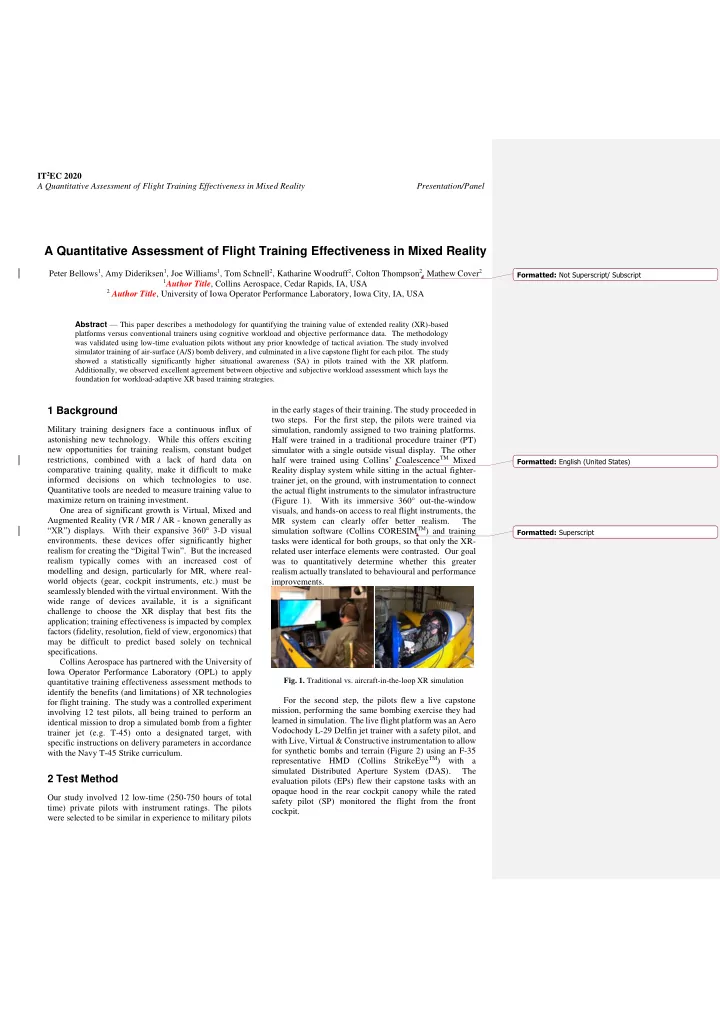

IT 2 EC 2020 A Quantitative Assessment of Flight Training Effectiveness in Mixed Reality Presentation/Panel A Quantitative Assessment of Flight Training Effectiveness in Mixed Reality Peter Bellows 1 , Amy Dideriksen 1 , Joe Williams 1 , Tom Schnell 2 , Katharine Woodruff 2 , Colton Thompson 2 , Mathew Cover 2 Formatted: Not Superscript/ Subscript 1 Author Title , Collins Aerospace, Cedar Rapids, IA, USA 2 Author Title , University of Iowa Operator Performance Laboratory, Iowa City, IA, USA Abstract — This paper describes a methodology for quantifying the training value of extended reality (XR)-based platforms versus conventional trainers using cognitive workload and objective performance data. The methodology was validated using low-time evaluation pilots without any prior knowledge of tactical aviation. The study involved simulator training of air-surface (A/S) bomb delivery, and culminated in a live capstone flight for each pilot. The study showed a statistically significantly higher situational awareness (SA) in pilots trained with the XR platform. Additionally, we observed excellent agreement between objective and subjective workload assessment which lays the foundation for workload-adaptive XR based training strategies. 1 Background in the early stages of their training. The study proceeded in two steps. For the first step, the pilots were trained via Military training designers face a continuous influx of simulation, randomly assigned to two training platforms. astonishing new technology. While this offers exciting Half were trained in a traditional procedure trainer (PT) new opportunities for training realism, constant budget simulator with a single outside visual display. The other half were trained using Collins’ Coalescence TM Mixed restrictions, combined with a lack of hard data on Formatted: English (United States) comparative training quality, make it difficult to make Reality display system while sitting in the actual fighter- informed decisions on which technologies to use. trainer jet, on the ground, with instrumentation to connect Quantitative tools are needed to measure training value to the actual flight instruments to the simulator infrastructure maximize return on training investment. (Figure 1). With its immersive 360° out-the-window One area of significant growth is Virtual, Mixed and visuals, and hands-on access to real flight instruments, the Augmented Reality (VR / MR / AR - known generally as MR system can clearly offer better realism. The “XR”) displays. With their expansive 360° 3 -D visual simulation software (Collins CORESIM TM ) and training Formatted: Superscript environments, these devices offer significantly higher tasks were identical for both groups, so that only the XR- realism for creating the “Digital Twin”. But the increased related user interface elements were contrasted. Our goal realism typically comes with an increased cost of was to quantitatively determine whether this greater modelling and design, particularly for MR, where real- realism actually translated to behavioural and performance world objects (gear, cockpit instruments, etc.) must be improvements. seamlessly blended with the virtual environment. With the wide range of devices available, it is a significant challenge to choose the XR display that best fits the application; training effectiveness is impacted by complex factors (fidelity, resolution, field of view, ergonomics) that may be difficult to predict based solely on technical specifications. Collins Aerospace has partnered with the University of Iowa Operator Performance Laboratory (OPL) to apply Fig. 1. Traditional vs. aircraft-in-the-loop XR simulation quantitative training effectiveness assessment methods to identify the benefits (and limitations) of XR technologies For the second step, the pilots flew a live capstone for flight training. The study was a controlled experiment mission, performing the same bombing exercise they had involving 12 test pilots, all being trained to perform an learned in simulation. The live flight platform was an Aero identical mission to drop a simulated bomb from a fighter Vodochody L-29 Delfin jet trainer with a safety pilot, and trainer jet (e.g. T-45) onto a designated target, with with Live, Virtual & Constructive instrumentation to allow specific instructions on delivery parameters in accordance for synthetic bombs and terrain (Figure 2) using an F-35 with the Navy T-45 Strike curriculum. representative HMD (Collins StrikeEye TM ) with a simulated Distributed Aperture System (DAS). The 2 Test Method evaluation pilots (EPs) flew their capstone tasks with an opaque hood in the rear cockpit canopy while the rated Our study involved 12 low-time (250-750 hours of total safety pilot (SP) monitored the flight from the front time) private pilots with instrument ratings. The pilots cockpit. were selected to be similar in experience to military pilots
Recommend
More recommend